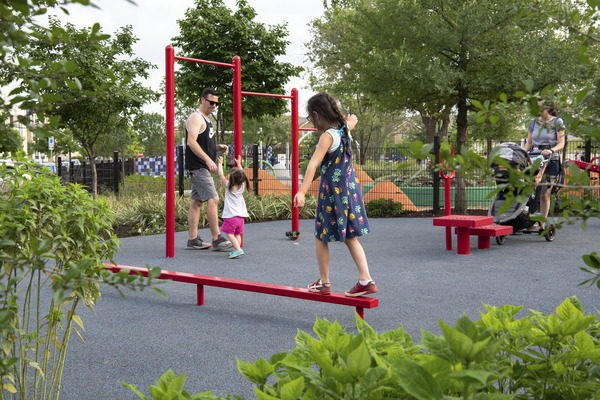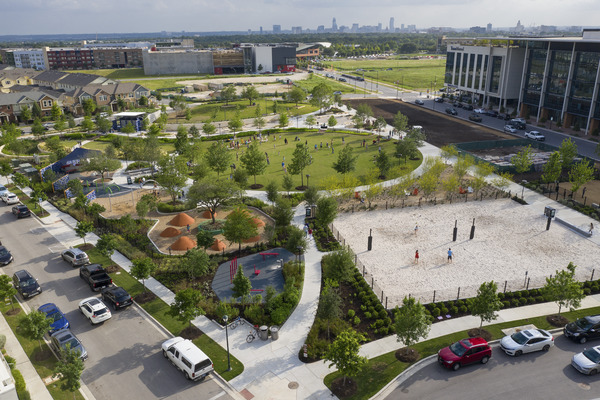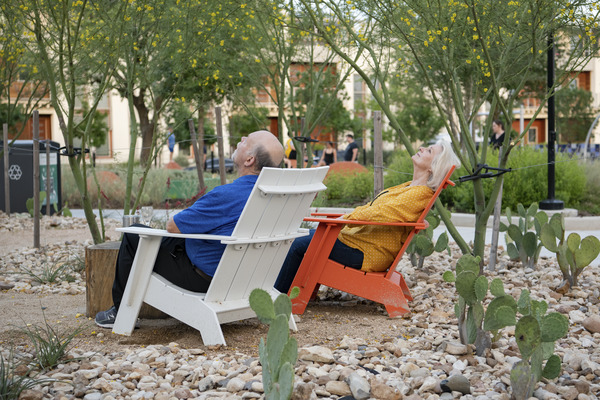
Community park landscape design and planning have a come a long way in the past decade. From including Fido-friendly dog parks to accommodating all generations, parks are no longer just a space with playgrounds for energetic kids. Communities are looking at their park systems with a much broader lens and see it as an opportunity to build healthy, thriving communities. As our cities continue to urbanize, many communities are looking to parks to provide citizens with the only outdoor recreation space they have to connect with nature.
Balancing space constraints and community needs with the capital budget to build a park often requires creative problem-solving. Recently opened Mary Elizabeth Branch Park (Branch Park) in the Mueller community, a mixed-income, mixed-use urban village located in Austin, Texas, is a testament to this. When we designed the 3.5-acre park we wanted to accommodate various recreation needs for a multigenerational community. The park features a creative children’s playground, dog run, sand volleyball court and an interactive waterscape along with shady areas for picnics and lawn space for people of all ages to enjoy.
We have incorporated new trends that landscape architects and designers are seeing across the nation in the Branch Park design including how to use the Sustainable SITES framework in planning. The requirements for SITES Certification, the LEED certification system for landscape and site design, are guiding the design of today’s parks and open spaces. We are designing spaces that are functional, beautiful and contribute to the betterment of the environment. This impacts every step of the design and planning process from sourcing materials and designing gardens to hiring labor and maintenance.
SITES certification is an important goal for master developer Catellus, the City of Austin and the design and construction teams, who all collaborated toward the design and development of Branch Park, plan to submit it for SITES certification in fall 2019. With this goal in mind, we incorporated a lush rain garden planted with native species that can tolerate the summer months and the wet fall and spring seasons. The rain garden treats the majority of stormwater from the park site, allowing the stormwater to slow down and percolate into the soil before it goes into the city storm sewer system. This garden is a major feature in the park, separating the interactive waterscape from the lawn and playground areas.

Speaking of H20, incorporating interactive waterscapes that are more than just decorative is also a hot trend in park design, despite their challenges. First, the waterscape needs to be incorporated into the design of the park, not a feature that stands out, which is hard to do given how large they are in size. Second, there are safety concerns with standing water, so more parks are looking for creative water features beyond pools. Third, the waterscapes have to appeal to a wide age range to get maximum use, so designers have to think of access and comfort with water-based on age. At Branch Park, water seeps, sprays and mists out of the stonework while interactive buttons allow people to activate certain features. In the winter when the water is shut off, this space becomes another plaza in the park, allowing it to be used year-round.

When designing Branch Park, we also looked at incorporating a multigenerational and multifunctional aspect, requiring us to design and plan spaces for all ages. We must balance the diverse needs of empty nesters seeking outdoor space in which to relax, young adults seeking a space for an evening kickball game, teenagers who want to hang out with friends and young kids who want to run around and just play. At Branch Park, the design team took all of this into account, incorporating plenty of seating options, shaded areas, viewing gardens, open spaces conducive to informal games and a playground.
When designing today’s parks, landscape architects and planners are also keeping our four-legged friends in mind. It’s a delicate balance as not everyone is comfortable around dogs, but with more people living in apartments or other housing without large yards, spaces for dogs are an important element to consider. In fact, the National Recreation and Park Association’s 2018 Agency Performance Review found that 55 percent of park and recreation agencies now have established dog area and those who don’t are either in the process of building one or in the planning stages. The dog run at Branch Park allows for neighborhood dogs (and their owners) to interact with one another in a leash-free zone. Pet waste bags and disposal systems and dog drinking fountains are supplied for users’ convenience. Trees surround the dog run allowing the space to be comfortable for owners and dogs throughout the year.
Author: Claire Hempel, principal at Design Workshop based in Austin, Texas, USA
A Principal at Design Workshop, Claire Hempel oversees a multitude of local, regional and international projects, including urban and regional parks, urban design, and community and environmental planning. With Claire’s background in planning and landscape architecture, Claire’s professional interests include public engagement, planning on multiple scales and empowering communities by providing them with the proper tools to achieve environmental, economic and community goals.
